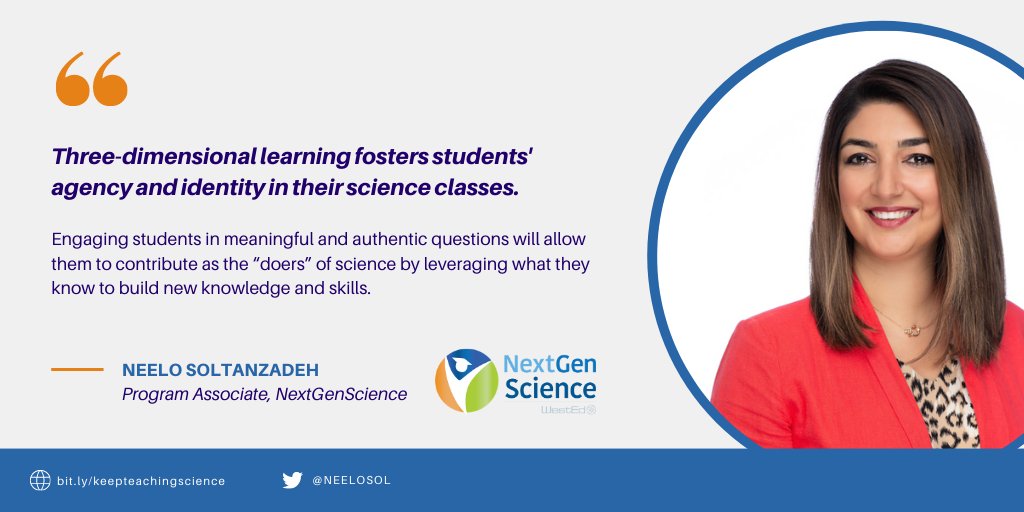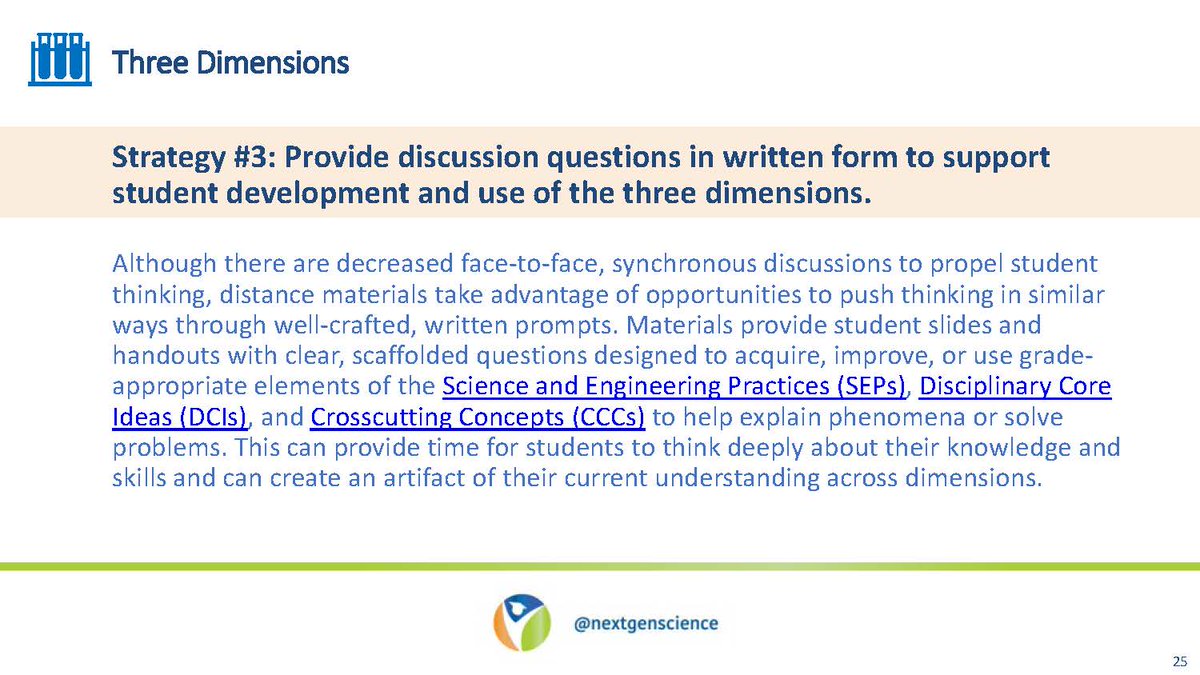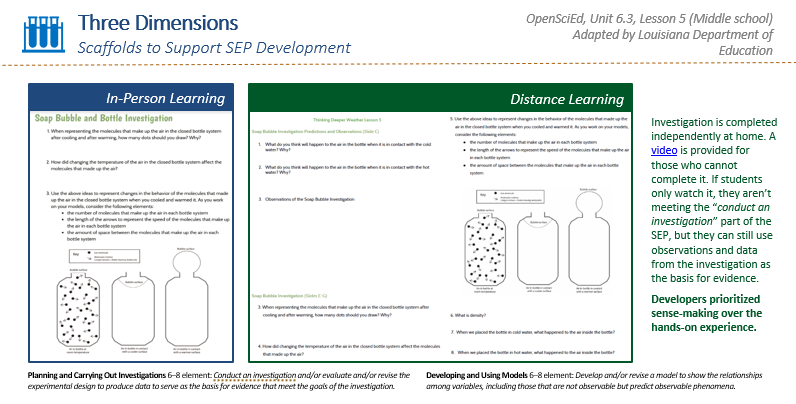Giving students the opportunity to develop and use grade-appropriate elements of the three dimensions is important because it shifts the focus of learning from memorizing discrete facts to using practices to figuring out and solving problems, using practices that scientists use.
One strategy for adapting three-dimensional science lessons for learning at a distance is to provide discussion questions in written form to support student development and use of the three dimensions. #KeepTeachingScience
In this @OpenSciEd @LA_Believes adaptation, class discussion questions are turned into written prompts on a student handout to push students’ thinking about properties of matter (DCI), cause and effect predictions (CCC), and developing and using models (SEP).
All students can engage with SEPs while learning at a distance. In this adaptation, students can complete the investigation at home or watch a video to make observations and use data as the basis for evidence while sense-making.
In this distance learning adaptation, converting the in-person class discussion questions to an individual task paired with a shared discussion board allows all students to participate more deeply in the discussion.
Try converting reflection questions from a discussion into a pre-work or post-work assignment for students. This can allow for deeper opportunities for students to think with powerful crosscutting concepts like Cause and Effect predictions.
Which Crosscutting Concept have you found to be powerful for your students? Reply to this thread and let us know!

 Read on Twitter
Read on Twitter


 Science and Engineering Practiceshttps://abs.twimg.com/emoji/v2/... draggable="false" alt="🔵" title="Blauer Kreis" aria-label="Emoji: Blauer Kreis">All students can engage with SEPs while learning at a distance. In this adaptation, students can complete the investigation at home or watch a video to make observations and use data as the basis for evidence while sense-making." title="https://abs.twimg.com/emoji/v2/... draggable="false" alt="🔵" title="Blauer Kreis" aria-label="Emoji: Blauer Kreis">Science and Engineering Practiceshttps://abs.twimg.com/emoji/v2/... draggable="false" alt="🔵" title="Blauer Kreis" aria-label="Emoji: Blauer Kreis">All students can engage with SEPs while learning at a distance. In this adaptation, students can complete the investigation at home or watch a video to make observations and use data as the basis for evidence while sense-making." class="img-responsive" style="max-width:100%;"/>
Science and Engineering Practiceshttps://abs.twimg.com/emoji/v2/... draggable="false" alt="🔵" title="Blauer Kreis" aria-label="Emoji: Blauer Kreis">All students can engage with SEPs while learning at a distance. In this adaptation, students can complete the investigation at home or watch a video to make observations and use data as the basis for evidence while sense-making." title="https://abs.twimg.com/emoji/v2/... draggable="false" alt="🔵" title="Blauer Kreis" aria-label="Emoji: Blauer Kreis">Science and Engineering Practiceshttps://abs.twimg.com/emoji/v2/... draggable="false" alt="🔵" title="Blauer Kreis" aria-label="Emoji: Blauer Kreis">All students can engage with SEPs while learning at a distance. In this adaptation, students can complete the investigation at home or watch a video to make observations and use data as the basis for evidence while sense-making." class="img-responsive" style="max-width:100%;"/>
 Disciplinary Core Ideashttps://abs.twimg.com/emoji/v2/... draggable="false" alt="🟠" title="Orangefarbener Kreis" aria-label="Emoji: Orangefarbener Kreis">In this distance learning adaptation, converting the in-person class discussion questions to an individual task paired with a shared discussion board allows all students to participate more deeply in the discussion." title="https://abs.twimg.com/emoji/v2/... draggable="false" alt="🟠" title="Orangefarbener Kreis" aria-label="Emoji: Orangefarbener Kreis">Disciplinary Core Ideashttps://abs.twimg.com/emoji/v2/... draggable="false" alt="🟠" title="Orangefarbener Kreis" aria-label="Emoji: Orangefarbener Kreis">In this distance learning adaptation, converting the in-person class discussion questions to an individual task paired with a shared discussion board allows all students to participate more deeply in the discussion." class="img-responsive" style="max-width:100%;"/>
Disciplinary Core Ideashttps://abs.twimg.com/emoji/v2/... draggable="false" alt="🟠" title="Orangefarbener Kreis" aria-label="Emoji: Orangefarbener Kreis">In this distance learning adaptation, converting the in-person class discussion questions to an individual task paired with a shared discussion board allows all students to participate more deeply in the discussion." title="https://abs.twimg.com/emoji/v2/... draggable="false" alt="🟠" title="Orangefarbener Kreis" aria-label="Emoji: Orangefarbener Kreis">Disciplinary Core Ideashttps://abs.twimg.com/emoji/v2/... draggable="false" alt="🟠" title="Orangefarbener Kreis" aria-label="Emoji: Orangefarbener Kreis">In this distance learning adaptation, converting the in-person class discussion questions to an individual task paired with a shared discussion board allows all students to participate more deeply in the discussion." class="img-responsive" style="max-width:100%;"/>
 Crosscutting Conceptshttps://abs.twimg.com/emoji/v2/... draggable="false" alt="🟢" title="Grüner Kreis" aria-label="Emoji: Grüner Kreis">Try converting reflection questions from a discussion into a pre-work or post-work assignment for students. This can allow for deeper opportunities for students to think with powerful crosscutting concepts like Cause and Effect predictions." title="https://abs.twimg.com/emoji/v2/... draggable="false" alt="🟢" title="Grüner Kreis" aria-label="Emoji: Grüner Kreis">Crosscutting Conceptshttps://abs.twimg.com/emoji/v2/... draggable="false" alt="🟢" title="Grüner Kreis" aria-label="Emoji: Grüner Kreis">Try converting reflection questions from a discussion into a pre-work or post-work assignment for students. This can allow for deeper opportunities for students to think with powerful crosscutting concepts like Cause and Effect predictions." class="img-responsive" style="max-width:100%;"/>
Crosscutting Conceptshttps://abs.twimg.com/emoji/v2/... draggable="false" alt="🟢" title="Grüner Kreis" aria-label="Emoji: Grüner Kreis">Try converting reflection questions from a discussion into a pre-work or post-work assignment for students. This can allow for deeper opportunities for students to think with powerful crosscutting concepts like Cause and Effect predictions." title="https://abs.twimg.com/emoji/v2/... draggable="false" alt="🟢" title="Grüner Kreis" aria-label="Emoji: Grüner Kreis">Crosscutting Conceptshttps://abs.twimg.com/emoji/v2/... draggable="false" alt="🟢" title="Grüner Kreis" aria-label="Emoji: Grüner Kreis">Try converting reflection questions from a discussion into a pre-work or post-work assignment for students. This can allow for deeper opportunities for students to think with powerful crosscutting concepts like Cause and Effect predictions." class="img-responsive" style="max-width:100%;"/>


